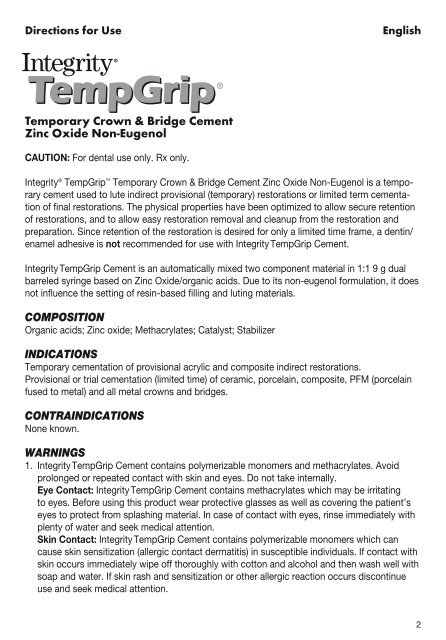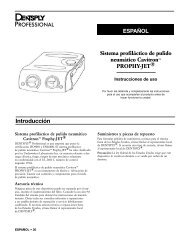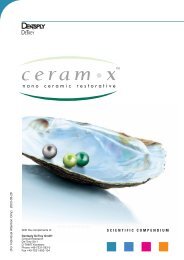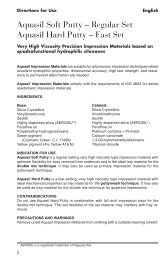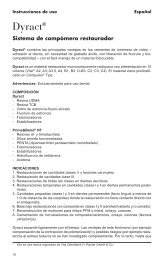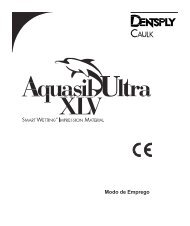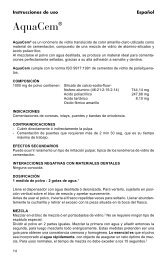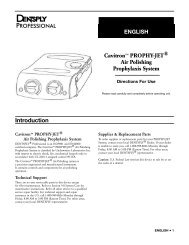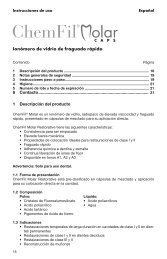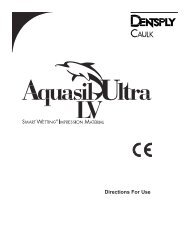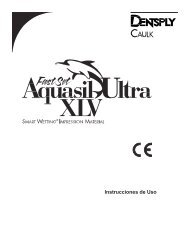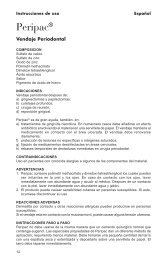Temporary Crown & Bridge Cement Zinc Oxide Non ... - Dentsply
Temporary Crown & Bridge Cement Zinc Oxide Non ... - Dentsply
Temporary Crown & Bridge Cement Zinc Oxide Non ... - Dentsply
Create successful ePaper yourself
Turn your PDF publications into a flip-book with our unique Google optimized e-Paper software.
Directions for UseEnglish®<strong>Temporary</strong> <strong>Crown</strong> & <strong>Bridge</strong> <strong>Cement</strong><strong>Zinc</strong> <strong>Oxide</strong> <strong>Non</strong>-EugenolCaution: For dental use only. Rx only.Integrity ® TempGrip <strong>Temporary</strong> <strong>Crown</strong> & <strong>Bridge</strong> <strong>Cement</strong> <strong>Zinc</strong> <strong>Oxide</strong> <strong>Non</strong>-Eugenol is a temporarycement used to lute indirect provisional (temporary) restorations or limited term cementationof final restorations. The physical properties have been optimized to allow secure retentionof restorations, and to allow easy restoration removal and cleanup from the restoration andpreparation. Since retention of the restoration is desired for only a limited time frame, a dentin/enamel adhesive is not recommended for use with Integrity TempGrip <strong>Cement</strong>.Integrity TempGrip <strong>Cement</strong> is an automatically mixed two component material in 1:1 9 g dualbarreled syringe based on <strong>Zinc</strong> <strong>Oxide</strong>/organic acids. Due to its non-eugenol formulation, it doesnot influence the setting of resin-based filling and luting materials.CompositionOrganic acids; <strong>Zinc</strong> oxide; Methacrylates; Catalyst; StabilizerIndications<strong>Temporary</strong> cementation of provisional acrylic and composite indirect restorations.Provisional or trial cementation (limited time) of ceramic, porcelain, composite, PFM (porcelainfused to metal) and all metal crowns and bridges.Contraindications<strong>Non</strong>e known.Warnings1. Integrity TempGrip <strong>Cement</strong> contains polymerizable monomers and methacrylates. Avoidprolonged or repeated contact with skin and eyes. Do not take internally.Eye Contact: Integrity TempGrip <strong>Cement</strong> contains methacrylates which may be irritatingto eyes. Before using this product wear protective glasses as well as covering the patient’seyes to protect from splashing material. In case of contact with eyes, rinse immediately withplenty of water and seek medical attention.Skin Contact: Integrity TempGrip <strong>Cement</strong> contains polymerizable monomers which cancause skin sensitization (allergic contact dermatitis) in susceptible individuals. If contact withskin occurs immediately wipe off thoroughly with cotton and alcohol and then wash well withsoap and water. If skin rash and sensitization or other allergic reaction occurs discontinueuse and seek medical attention.
Oral mucosa contact: Avoid contact with oral soft tissues. If accidental contact occurs,flush mucosa with plenty of water and expectorate water. If sensitization of mucosa persists,seek medical attention immediately.2. Integrity TempGrip <strong>Cement</strong> should not be used with patients who have a history of severeallergic reaction to any of the components.Precautions1. This product is intended to be used as specifically outlined in the Directions for Use. Any useof this product inconsistent with the Directions for Use is at the discretion and sole responsibilityof the practitioner.2. Wear suitable protective eyewear, clothing and gloves. Protective eyewear is recommendedfor patients.3. Integrity TempGrip <strong>Cement</strong> should extrude easily. DO NOT USE EXCESSIVE FORCE. Excessivepressure may result in unanticipated extrusion of the material or cause syringe rupture.StorageIntegrity TempGrip <strong>Cement</strong> should be stored in the original syringe only, kept out of directsunlight and stored in a well ventilated place at temperatures between 8-25 °C/46-77 °F. Allowmaterial to reach room temperature prior to use. Protect from moisture. Do not freeze. Do notuse after expiration date.Adverse ReactionsProduct may irritate the eyes and skin. Eye contact: irritation and possible corneal damage.Skin contact: irritation or possible allergic response. Reddish rashes may be seen on the skin.Mucous Membranes: inflammation, edema, sloughing. (See Warnings)Interactions1. Integrity TempGrip <strong>Cement</strong> will adhesively bond to most dental adhesives. Use of a dentin/enamel adhesive may make restoration removal and cleanup difficult.2. Integrity TempGrip <strong>Cement</strong> may adhesively bond to freshly placed methacrylate andcomposite core buildup materials and provisional restorations. Buildups and provisional restorationsshould be fully cured, prepared, and rinsed thoroughly with forceful air/water spraybefore cement application. If surfaces were not prepared or instrumented, wipe thoroughlywith alcohol soaked gauze, then rinse with air/water spray.3. Eugenol containing materials should not be used in conjunction with this product because theymay interfere with hardening and cause softening of the polymeric components of the material.Step-by-Step InstructionsProvisional, temporary, or periodic term restoration cementation1. Treatment of the Preparation1.1 Following tooth preparation and fabrication of the provisional restoration, clean enamel,dentin, any buildup material and provisional restoration thoroughly with water spray. Blotdry with a moist cotton pellet until there is no pooling of water, leaving a moist, glisteningsurface. Do not desiccate. Etching of tooth surfaces is NOT recommended. For directand indirect pulp capping, cover the dentin close to the pulp (less than 1mm) with a hardsetting calcium hydroxide liner (Dycal ® Liner) following manufacturer’s directions for use.
2. Treatment of the Restoration2.1 Check the fit and esthetics of the provisional restoration. If increased retention is desired,microetching (sandblasting) with 50µ alumina the internal surfaces of the restoration isrecommended. The internal surface of the restoration should be clean and dry prior tocementation.3. <strong>Cement</strong>ation Technique3.1 Remove syringe’s cap and discard cap. The used mixing tip can be disinfected and leftin place until the next use to serve as a self-sealing cap. Dispense and discard a smallamount of material from the dual barreled syringe. Be sure material is flowing freely fromboth ports. Holding syringe vertically, carefully wipe away excess so base and catalystdo not cross contaminate and cause obstruction of the ports.3.2 Install a mixing tip on the cartridge by lining up the v-shaped notch on the outside of themix tip with the v-shape notch on the syringe flange. Turn colored mix tip cap 90 degreesin a clockwise direction to lock in place on syringe.3.3 Gently depress syringe plungers to begin the flow of material. DO NOT USE EXCESSIVEFORCE. If force is encountered, remove syringe from operating field, remove and discardmix tip. Check for obstruction and confirm material is flowing from both syringe barrels.Wipe barrels and install new mix tip as outlined above. Dispense a small amount throughthe mix tip onto a mixing pad and discard.3.4 Without delay, using gentle pressure, apply a thin, uniform layer of cement to the entireinternal surface of the restoration directly from the mix tip. At room temperature, IntegrityTempGrip <strong>Cement</strong> offers a minimum work time of 1 minute. Restoration should beseated in the mouth within 1 minute from start of mix.3.5 Seat the restoration with gradual pressure. A gentle rocking or vibratory motion maybe helpful to insure optimal seating. Following placement, Integrity TempGrip <strong>Cement</strong>will self-cure set in the mouth in approximately 2-3 minutes. Protect restoration fromcontamination and movement during the setting time.3.6 Remove gross excess from marginal areas. Use an instrument such as a bluntedexplorer, periodontal probe or a clean, dry brush tip. Restoration should not be movedor torqued during removal of gross excess cement. Special attention should be paid tointerproximal areas using floss to remove excess cement.3.7 Following the self-cure set of approximately 5 minutes from start of mix, check andadjust occlusion and polish as necessary. Patient may then be dismissed.4. Restoration Removal4.1 Using hemostats, Baade pliers, or other suitable crown removal instrument, gentlygrasp and remove restoration along the path of insertion. Avoid twisting or rocking ofprovisional to avoid preparation and/or restoration damage. Technique Tip: For finalrestorations requiring periodic removal for periodontal maintenance procedures, etc.,features incorporated in the restoration design which facilitate removal such as dimplesor cast removal buttons are strongly recommended.4.2 Following removal of the restoration, residual cement remaining on the preparationand/or internal surfaces of the restoration, may be removed with a sharp scaler, exploreror other suitable hand instrument.4.3 Clean enamel and dentin with a rubber cup and pumice or a cleaning paste such asNupro ® Prophylaxis Paste. Wash thoroughly with water spray and blot dry.4.4 Proceed to final cementation according to cement manufacturer’s instructions, or repeatlimited term cementation with Integrity TempGrip <strong>Cement</strong> by following steps above.
CleaningThe syringe may be cleaned using a disposable towel soaked with hot water and soap or detergent.Excess material may be removed with an alcohol-moistened gauze.DisinfectionThe syringe and used mixing tip left in place on the syringe for storage, if exposed spatter orspray of body fluids or that may have been touched by contaminated hands, or oral tissues,should be disinfected with a hospital-level disinfectant. Acceptable disinfectants are EPA-registeredas tuberculocidal. Iodophors, sodium hypochlorite (5.25%), chlorine dioxide and dualor synergized quaternaries are approved disinfectants. Disinfect the syringe by spraying thesyringe with any recommended hospital-level surface disinfectant for the contact time recommendedby the disinfectant manufacturer for optimum results. Spraying with glutaraldehydeis not recommended. Some phenolic-based agents and iodophor-based products may causesurface staining. Agents containing organic solvents, such as alcohol, may tend to dissolve theplastic. The disinfectant manufacturer’s directions should be followed properly for optimumresults. Water-based disinfectant solutions are preferred.Lot Number and Expiration Date1. Do not use after expiration date. ISO Standard used: “YYYY/MM”2. The following numbers should be quoted in all correspondences:• Reorder number• Lot number on the syringe• Expiration date


